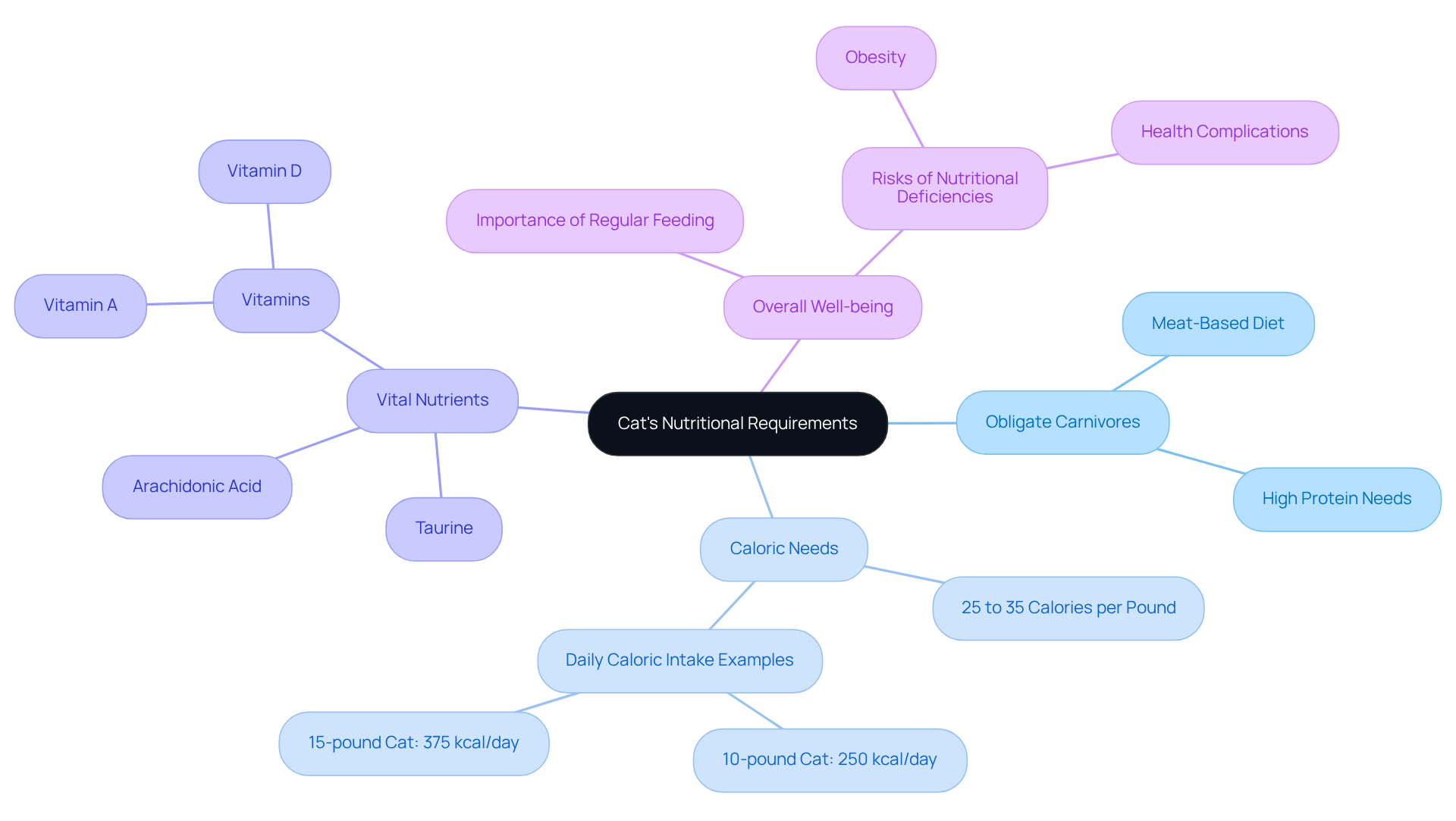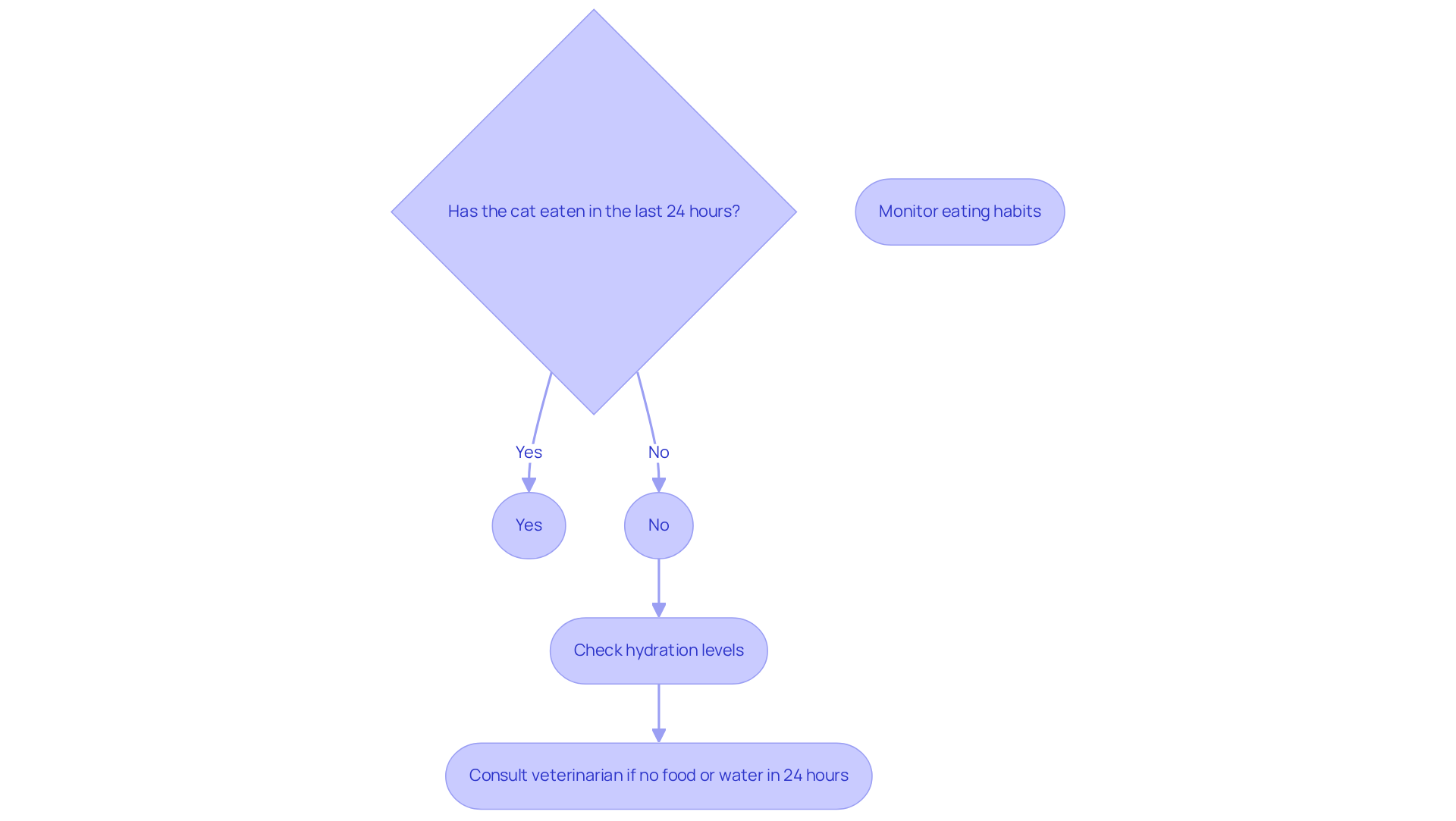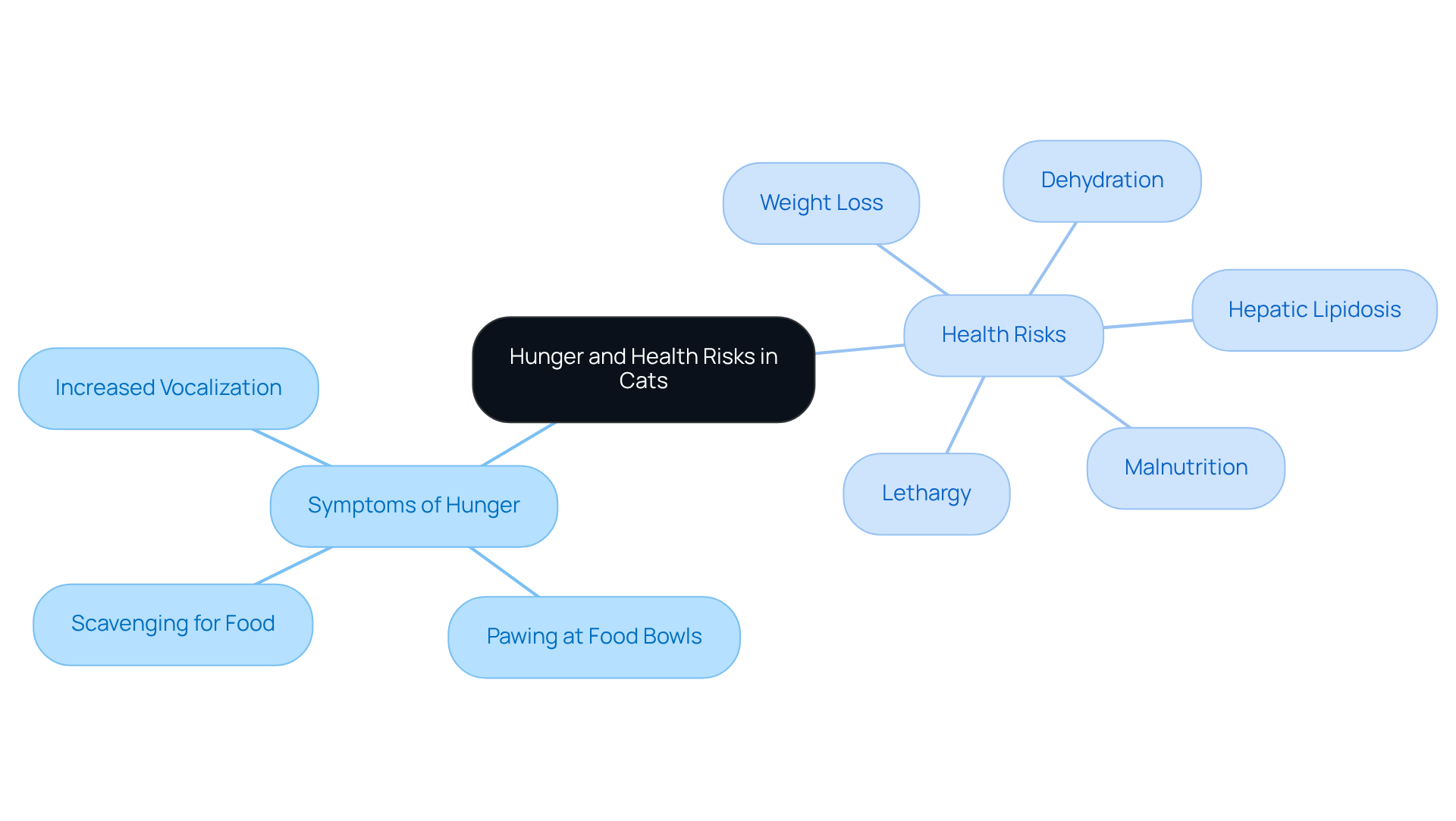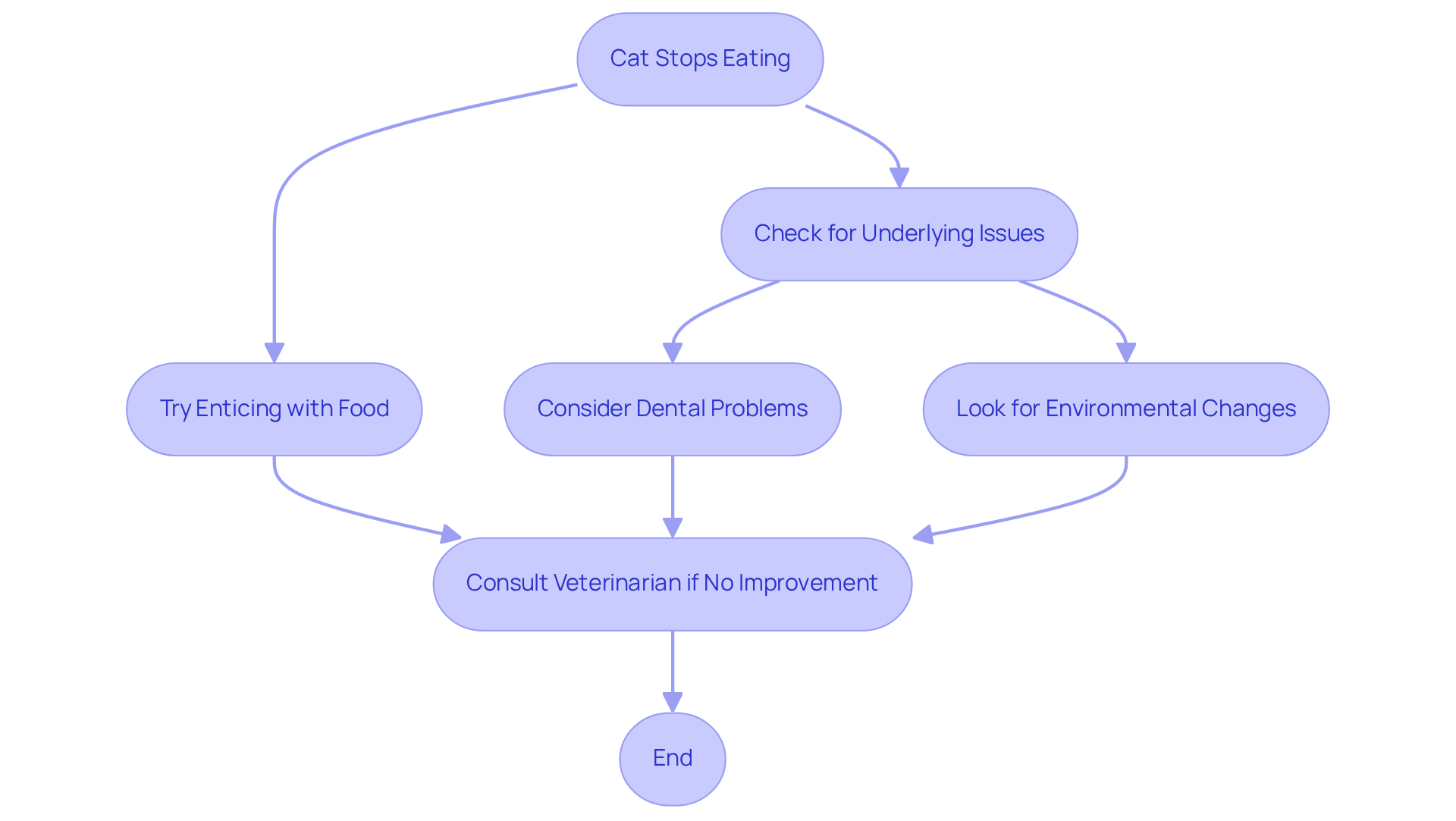
How Long Can a Cat Go Without Food? Essential Steps for Pet Owners
Overview
As a devoted cat owner, it’s natural to worry about your furry friend’s well-being, especially when it comes to their eating habits. Cats can typically go without food for one to two weeks, but it’s crucial to understand that significant health risks can arise after just 24 hours without nourishment. Conditions like hepatic lipidosis can develop, which can be quite serious. It’s heart-wrenching to think about, but by being vigilant and monitoring your cat’s eating patterns, you can help ensure their health and happiness.
If you notice that your beloved cat hasn’t eaten for more than a day, it’s important to seek veterinary care. Prolonged fasting can lead to severe health complications, and your pet deserves the best care possible. Remember, you’re not alone in this; many pet owners share your concerns and want to provide their cats with the love and attention they need. By reaching out for help, you’re taking a compassionate step towards ensuring your feline companion stays healthy and safe.
Introduction
Understanding a cat’s dietary needs is essential for any pet owner, especially when it comes to ensuring their health and well-being. As obligate carnivores, cats require a balanced diet rich in proteins and essential nutrients to thrive. However, it can be distressing when a cat refuses to eat. The implications of this behavior can be serious, as even a short period without food may lead to alarming health risks.
- How long can a cat go without food before it becomes a life-threatening concern?
- What steps can you take to ensure your furry companion remains healthy and happy?
This guide explores the vital aspects of feline nutrition, the dangers of fasting, and the proactive measures that you, as a caring owner, can implement when your cat stops eating.
Understand a Cat’s Nutritional Requirements
As devoted cat owners, it’s essential to recognize that our feline friends are obligate carnivores, meaning their diet must primarily consist of meat. This understanding is crucial, as cats require a delicate balance of proteins, fats, vitamins, and minerals to thrive. Imagine the peace of mind you’ll feel knowing that a typical adult cat needs about 25 to 35 calories per pound of body weight daily, with a diet rich in protein—at least 26% of their caloric intake—and low in carbohydrates.
Think about the vital nutrients that contribute to their well-being, such as taurine, arachidonic acid, and specific vitamins. These components are not just dietary requirements; they are essential for preserving the health and happiness of your beloved pet. By understanding these needs, you can appreciate the importance of regular feeding and the potential risks associated with how long a cat can go without food.
Caring for a cat is not just about meeting their nutritional needs; it’s about nurturing their overall well-being. By prioritizing their diet, you are taking a significant step towards ensuring they lead a healthy and fulfilling life. Remember, you’re not alone in this journey—many others share your commitment to providing the best for their pets, and together, we can create a community of caring cat owners.

Determine Safe Time Limits Without Food
Theoretically, one might wonder how long can a cat go without food, as they can endure without sustenance for one to two weeks if they have access to water. However, any period beyond 24 hours without nourishment raises significant concerns about how long can a cat go without food and its impact on their well-being.
After this duration, a cat’s body begins to utilize fat reserves for energy, which can lead to serious complications, including hepatic lipidosis—a potentially fatal liver disease. Symptoms of this condition may include:
- Jaundice
- Lethargy
- Rapid weight loss
Furthermore, cats are at risk of dehydration after 24 hours without water, which can further complicate their health. Therefore, it is crucial for pet owners to closely monitor their cat’s eating habits and hydration levels. If a cat has not eaten for over 24 hours or has not consumed water during this time, seeking prompt veterinary consultation is essential to prevent serious consequences.
Factors such as age, preexisting medical conditions, and hydration levels can influence how long can a cat go without food, making it important to evaluate each situation individually. Possible reasons for a cat not eating might include dental disease, stress, or other underlying medical issues, highlighting the need for a thorough assessment.
Remember, your cat’s health is paramount, and being attentive to their needs fosters a loving and supportive environment.

Recognize Symptoms of Hunger and Health Risks
As a loving cat owner, it’s natural to worry when you notice signs that your feline friend might be hungry. Increased vocalization, pawing at food bowls, and scavenging for food are common indicators that your cat is seeking nourishment. However, if your cat begins to show signs of lethargy, weight loss, or changes in behavior, it’s essential to recognize that these could point to more significant health risks. Prolonged fasting can lead to serious consequences, including malnutrition, dehydration, and even hepatic lipidosis, a serious liver disease that can affect your beloved pet.
It’s important to be aware that conditions such as hyperthyroidism, which impacts around 13.9% of cats, can lead to an increased appetite. This is a vital consideration when evaluating your cat’s overall well-being. As a caring pet owner, staying vigilant for these symptoms is crucial. If your cat has not eaten for more than a day, it is important to consider how long can a cat go without food and seek veterinary advice promptly. Early intervention is key to preventing long-term health issues.
Additionally, if you notice symptoms like abdominal pain or bloating, these warrant immediate veterinary attention. Remember, your cat relies on you for care and support, and recognizing these signs can make all the difference in ensuring their health and happiness.

Take Action If Your Cat Stops Eating
If your beloved cat hasn’t eaten for over a day, it’s crucial to act swiftly. We understand how distressing this situation can be for you. Begin by exploring possible underlying issues, such as dental problems that may cause pain and discomfort, leading to a reluctance to eat. Additionally, consider any recent changes in their environment, as stressors can significantly impact their well-being. Remember, if you are concerned about how long a cat can go without food and your cat hasn’t consumed food for more than 48 hours, seeking urgent veterinary advice is essential.
To entice your cat, try offering a variety of options, including wet food or slightly warmed dishes, which can enhance the aroma and make mealtime more appealing. If your cat continues to refuse food, it’s vital to consult your veterinarian. They may recommend a thorough examination to uncover any medical conditions contributing to the appetite loss, such as pancreatitis or kidney disease. In some instances, appetite stimulants or a specialized diet may be suggested to encourage your furry friend to eat again.
As Dr. Cassandra Vlahaki, our lead veterinarian, wisely notes, understanding the reasons behind a cat’s loss of appetite is key to effective treatment. We are here to support you and your pet during this challenging time, ensuring that you have the resources and guidance needed to help your cat feel better.

Conclusion
Understanding the nutritional needs of our beloved cats is essential for every pet owner. A diet rich in proteins and essential nutrients is not just important; it is vital for their overall health and well-being. While cats may have the ability to go without food for a time, the risks associated with prolonged fasting remind us of the importance of regular feeding. Acknowledging these dietary requirements not only ensures a happy and healthy pet but also strengthens the bond we share with our feline companions.
This article highlights that although cats can theoretically survive without food for one to two weeks, significant health risks can arise after just 24 hours without nourishment. Symptoms like lethargy, weight loss, and potential liver disease serve as critical indicators that deserve our immediate attention. By understanding the signs of hunger and the implications of not eating, we empower ourselves as pet owners to take proactive measures in safeguarding our cats’ health.
Ultimately, our responsibility as pet owners extends well beyond simply providing food; it encompasses a heartfelt commitment to monitoring our cats’ eating habits and recognizing when intervention becomes necessary. By staying informed and attentive, we can ensure our cats receive the care they need, nurturing a thriving, healthy life for our cherished companions. Taking action at the first signs of appetite loss not only enhances a cat’s quality of life but also deepens the connection between pet and owner, underscoring the importance of vigilance in pet care.
